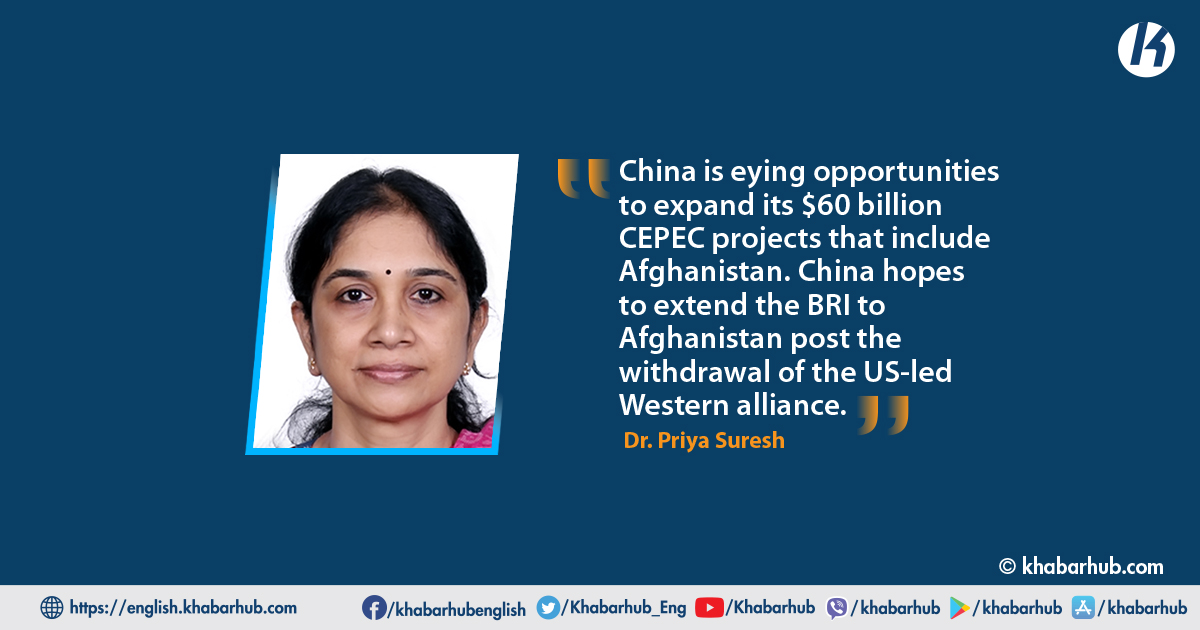Following the withdrawal of the United States from Afghanistan, China emerged as the foremost country to establish diplomatic relations with the Taliban.
Chinese Foreign Ministry spokesperson Wang Wenbin stated that China’s position on Afghanistan is consistent and clear and expressed its readiness to maintain communication with the new Taliban government in Afghanistan.
China hardly has any qualms in nurturing this relationship and wants to assert its position discarded by the United States.
How is China trying to fit into the Taliban Afghanistan?
Beijing- Afghanistan relationship is a twofold approach. Firstly, it is commercial. China will seek to revive its business prospects and ventures in Afghanistan and the Taliban would support this initiative to upturn investments in the country.
At this point of time, the Afghan economy is fragile and dependent on the support of Western donors that will be completely cut off.
The Taliban government encourages investments of any kind, discourages any form of interference. Second, for Beijing, the non-interference is a reassurance that the Taliban will not export extremism into the Xinjiang region which shares a common border with Afghanistan.
China-Afghanistan engagement shows tangible paybacks. The Chinese Foreign Ministry Spokesperson Wang Wenbin on the extension of BRI projects into Afghanistan and the country under Taliban rule will provide a favorable situation for foreign investors vice versa the Afghan government feels BRI will be in its interest.
A win-win situation that shall avoid any sermon on issues of human rights in both China and Taliban ruled Afghanistan.
The Taliban-ruled Afghanistan seems to be an effective partner for China. Third, unlike the West, China from the beginning has been ready to deal with any government regardless of its configuration.
China quickly carved an independent niche calling the international community to remove obstacles and unfreeze assets. Along with Pakistan, China provided food aid, vaccine, and medicines.
China’s response towards Taliban Afghanistan has been friendly but yet to officially recognize the Taliban government in Afghanistan.
In the recent past, China has sealed the 50-mile border with Afghanistan and continues to emphasize that the Taliban government shall not act in any way that will be detrimental to China’s interest.
The other concern is the East Turkestan Islamic movement (ETM) increased its presence in Afghanistan make them active fighters in the region calling for greater vigilance on China’s part.
The other aspect is China’s growing economic involvement in the region has created a greater vulnerability. Drug trafficking, terror networks and displacement endangering the Chinese nationals in Afghanistan and its spillover into the Chinese territory bordering Afghanistan.
Afghanistan hosts rich mineral deposits such as gold, oil, bauxite, iron ore, natural gas, lead, etc., with the US withdrawal, the Taliban government has re-captured the mineral deposits.
Beijing can be a major economic investor that will benefit Afghanistan significantly. China can offer infrastructure development, industry building, and technology support to tap the abundant natural resources.
The current situation seems to be right for China to prioritize its BRI investments. At the same time, the concerns that worry the Chinese are the risk of terror outfits and the border that China shares with Afghanistan any spillover effect can put the BRI at risk.
China’s Belt & Road Initiative (BRI) could get a greater reach & the Taliban believes that it will benefit the development and prosperity of the country.
The China-Pakistan Economic Corridor (CPEC) incorporating three countries China-Pakistan-Afghanistan did not make much headway owing to political differences that were underway with the previous Ashraf Ghani government in Kabul.
China-Afghanistan engagement shows tangible paybacks. The Chinese Foreign Ministry Spokesperson Wang Wenbin on the extension of BRI projects into Afghanistan and the country under Taliban rule will provide a favorable situation for foreign investors vice versa the Afghan government feels BRI will be in its interest.
China is eying opportunities to expand its $60 billion CEPEC projects that include Afghanistan. China hopes to extend the BRI to Afghanistan post the withdrawal of the US-led Western alliance.
Few concerns remain about incorporating Afghanistan into the BRI. The most obvious is the security concerns that can hamper Chinese investment.
The Taliban has publicly claimed that it will not interfere in China’s internal matters, yet the question is about how they will deal with the other Islamist movements in the region.
China’s engagement in Afghanistan predates the BRI the Mes Aynak copper mine in 2008 and another Chinese company secured the right to improve an oil field in the Amu Darya in 2011.
These projects never happened. China is a forerunner in mining rare earth materials and Afghanistan has abundant earth mineral resources.
The current situation seems to be right for China to prioritize its BRI investments. At the same time, the concerns that worry the Chinese are the risk of terror outfits and the border that China shares with Afghanistan any spillover effect can put the BRI at risk.
(Dr. Priya Suresh is an Assistant Professor at the Department of International Studies, Stella Maris College (Autonomous), Chennai, India)









Comment